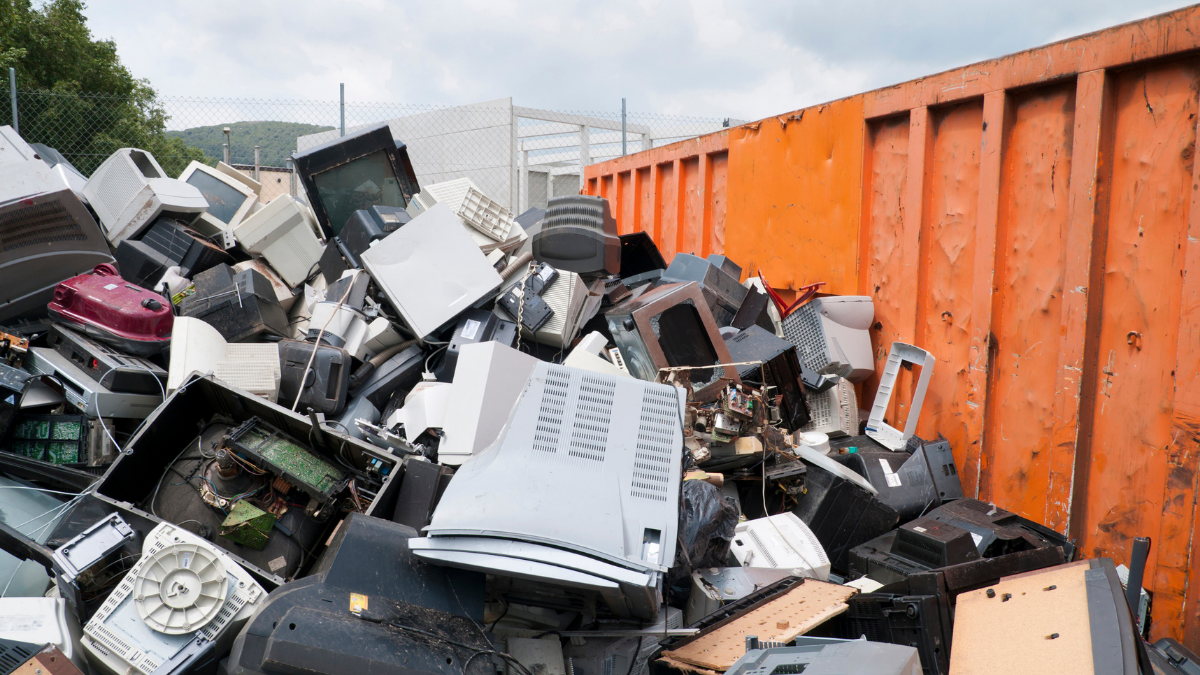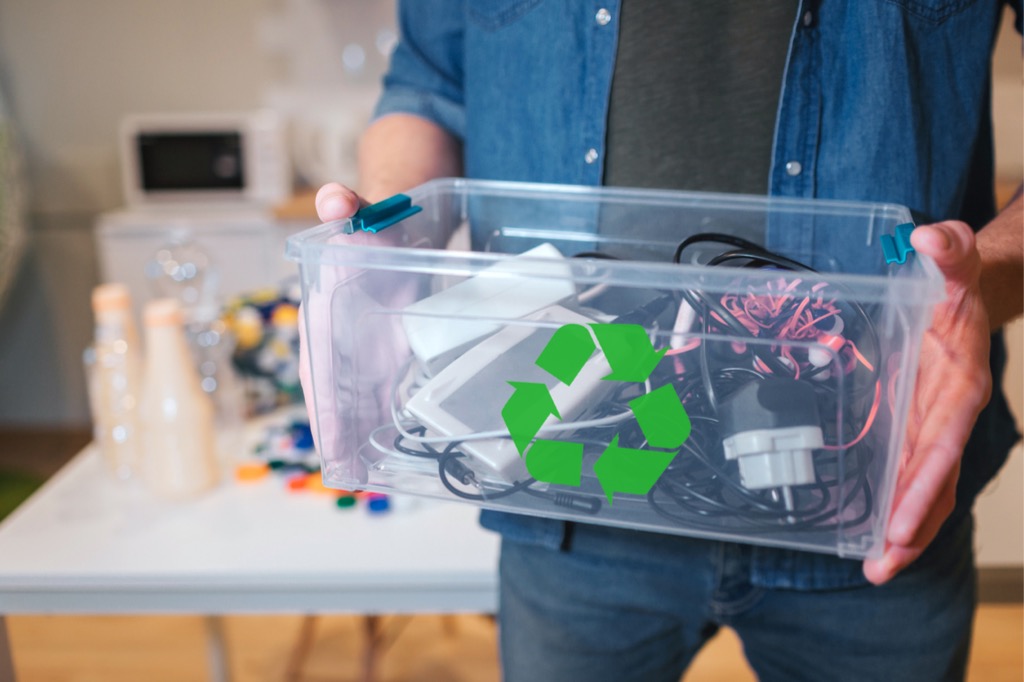The Growing Problem of Electronic Waste (E-Waste)
Introduction
The rapid evolution of technology and the constant introduction of new hardware means that electronic waste (e-waste) is no longer a definition for damaged and obsolete equipment. Now, even technology that is in perfect working order is frequently discarded in exchange for newer and trendier technology.
This practice has resulted in a growing global crisis in e-waste disposal and management. According to a 2019 report by the Global E-waste Statistics Partnership (GESP), electronic waste volumes grew by 21% to 53.6 million metric tonnes between 2014 – 2019. Additionally, only 17.4% of electronic garbage was formally processed in 2019.

Such statistics highlight the growing problem of electronic waste and the urgent action needed from governments, consumers, manufacturers, and other stakeholders to curb e-waste.
Managing e-waste is critical to preserving a healthy environment and contributing to a reduction in carbon emissions. To illustrate this, the 17.4 % of electronic garbage that is collected and recycled protected the atmosphere from 15 million tonnes of carbon dioxide.
Despite the large amounts of e-waste generated, governments are working hard to mitigate the effects of pollution by enforcing electronic waste management regulations and practices and increasing the awareness of their populations.
Learn more about what constitutes e-waste and what to do with electronic waste.
What is E-Waste?
E-waste is defined as any discarded electronic or electrical product that’s considered obsolete, damaged, nearing, or at the end of its useful life. These electronic waste products include anything with batteries, a cord, and/or a plug.
In addition, electronic garbage is any electronic or electrical material planned for recycling, refurbishment, reuse, resale, or recovery.
The breakdown of e-waste without proper management is what releases toxic compounds from electronic equipment to the environment.
Hence, the best route to take in electronic waste management is to apply the 4R principles of Reduction, Reusing, Recycling, and Recovering. If your only option is to discard the electronic garbage, there are safe disposal initiatives that help in reducing the release of toxic electronic waste.
Such initiatives are often spearheaded by the government, not-for-profit organizations, recycling companies, and product manufacturers.


Make an Informed Decision
Common E-waste Items
E-waste examples include ICT equipment, communication devices, household appliances, among other equipment. In detail, electronic and electrical waste items include:
IT Equipment and Communication Devices
These devices handle computing and communication activities. They are desktops, laptops, networking devices, printers, scanners, keyboards, mice, mobile phones, telephones, radio, TVs, video-recording devices, audio equipment, and musical devices.
Large and Small Household Appliances
Large and small home appliances include equipment that enables household functions electrically or electronically. These appliances consist of refrigerators, cookers, vacuum cleaners, lawnmowers, electrical fans, air conditioners, toasters, hair cutting and drying appliances, and heating appliances.
Electrical Tools
These are tools used for drilling, sawing, cutting, grinding metal, wood, plastic, or other materials. These tools also do riveting, screwing, nailing, and removing nails. In addition, the electrical tools solder and metallic weld items.
Lighting Materials
Lighting components fall under electronic waste products. These include fluorescent bulbs, high-intensity lamps, pressure sodium bulbs, metal halide bulbs, and any other lighting item designed to discharge electricity or light.
Healthcare Equipment
Medical equipment that falls under the electronic waste category includes radiotherapy devices, MRI scanners, ventilators, incubators, freezers, cardiology devices, and any other electrical or electronic equipment utilized in the medical field.
Monitoring Equipment
Monitoring devices include any item used to monitor and detect unusual activity. Monitoring equipment comprises smoke detectors, security cameras, body and luggage scanners, thermostats, and heat regulators. Additional items categorized under electronic waste and can be disposed of, recycled, or recovered include:
- Nickel, cadmium, or lead batteries
- Automatic dispensers
- Sports and leisure equipment
Is "E-waste" Clearly Defined?
The electronic waste definition broadly applies to business and consumer equipment that either has electronic or electrical components. The unclear definition is due to the term applying to both ICT equipment and Household appliances, all of which perform similar functions.
So to clarify the term, the word” e-waste” applies to either electronic or electric equipment.

E-waste Issues and Dangers
Electronic waste poses one of the most challenging environmental issues across the globe, especially in developing nations. Additionally, the electronic waste contains harmful materials that contaminate soil, air, and water, leading to compromised health and safety of animals and humans.
E-waste releases toxic compounds such as lead, mercury, cadmium, brominated flame retardants, barium, lithium, and beryllium if not correctly handled and disposed of. Additionally, the plastic housings covering the electronic equipment is often made of or contain polyvinyl chloride (PVC), a substance that contaminates natural resources if not properly handled.
These chemicals can cause health issues such as congenital disabilities, brain damage, Kidney, liver, heart, reproductive, and nervous system complications.
- Selenium: Selenium is used to manufacture solar cells, circuit boards, light meters, photocells, and battery lead plates. High exposure to selenium causes issues such as nail and hair deformations.
- Cadmium: Cadmium is used to manufacture batteries, aircraft electroplates, and cathode-ray tubes. The compound is classified as a carcinogen due to high air, soil, and water exposure levels. In addition, cadmium ends up polluting our environment due to improper recycling practices where recycling companies incinerate electronic products to recover precious metals for resale.
- Mercury: Mercury is popularly used to manufacture thermostats, fluorescent tubes, flat-screen monitors, and LED products. Therefore, when consumers and manufacturers dispose of mercury-containing products inappropriately, they release mercury into the environment. This poor practice ends up contaminating soil and water. Mercury contamination causes impaired growth, blood chemistry alteration, and reduced production.
- Lead: Even though lead-based paints for residential use were outlawed in 1978, manufacturers still use the metal to manufacture electronic parts. Lead is used in batteries, metal alloys, photovoltaics, and soldering activities. Excess lead exposure leads to respiratory issues.
- Beryllium: Beryllium is a metal used for manufacturing electronic equipment such as x-rays, communication devices, and IT equipment. Prolonged exposure to beryllium can cause chronic beryllium disease and lung cancer.
So what does e-waste contain? Harmful chemicals in poorly managed electronic waste disposal pose the following dangers to human health:
What to do with E-waste?
There are many environmentally safe ways to dispose of your electronic waste without discarding it trash. They include:
Dispose of your Electronic Waste with an Accredited Recycling Company
TechReset is a leading electronics recycling company that accepts e-waste from companies and individuals and have the processes and technology to recycle e-waste safely without releasing harmful chemicals.
When looking for a recycling company, it is important to note the electronic waste management certifications. These should include:
- Basel Convention Compliance: Ensures companies reduce the movement of harmful and hazardous electronic waste from developed to developing countries.
- Blancco Certification: Provides standards and procedures for secure data erasure.
- R2(Responsible Recycling) certification: Ensures organizations conduct responsible and legal international trade that adheres to environmental, data security, and health safety requirements.
- ISO 9001:14001:45001: These ISO standards oversee occupational health and safety management systems for more straightforward quality and environmental integration.
Sell Outdated Electronic Equipment
Plenty of consumers can get years for use from an outdated phone, computer, or printer. In most cases, the equipment still performs essential functions or would require a few repairs to get it to suitable working condition.
Consider selling your unwanted electronics via platforms such as eBay, Amazon, or your local marketplaces.
Donate Your Electronic Equipment
Many not-for-profit organizations, schools, and disadvantaged communities need IT equipment for their learning activities. Donating your unwanted IT equipment is a great way to give back while protecting the environment. Many recycling companies have donation programs. For example, TechReset works with reBOOT Canada to repurpose equipment.
Before reselling or donating mobile phones, PC’s or laptops, ensure you clear your personal data, browsing history and uninstall unnecessary programs.

See how much your IT equipment is worth
E-Waste and Data Security

A critical concern with electronic waste management is data security. Cybercriminals can retrieve your data from discarded equipment that can cause financial, personal or reputational harm. Therefore, it’s vital to ensure you safely handle data before disposing of your electronics.
For organizations dealing with corporate e-waste, cybercriminals can use your employee, customer, supplier, and management data to launch malicious attacks against them.
To prevent security vulnerabilities and threats from disposed of devices, ensure your recycling company conducts secure data erasure to wipe out all data from your IT e-waste.
Secure e-waste data erasure uses software to overwrite and cleanse data on storage devices to prevent anyone from recovering the data.

See how we can solve your hard drive destruction needs
International E-Waste Management Network
The International E-Waste Management Network (IEMN) promotes and strengthens best practices on electronic waste management across the globe. The network achieves this mandate by enabling officials worldwide to exchange best practices on electronic garbage management according to their experiences within their regions. The network’s fundamental principles include:
- Assess and report on downstream markets for electronic waste equipment
- Assess new process and technology barriers and opportunities in managing electronic waste
- Recommend better strategies for building relationships across industries
- Define audit requirements to inspect facilities and protect employee health and environmental safety
We hope we have given you some insight into the dangers of e-waste and how to dispose of it responsibly. If you are looking for more information about e-waste management, we encourage you to contact our team of experts.